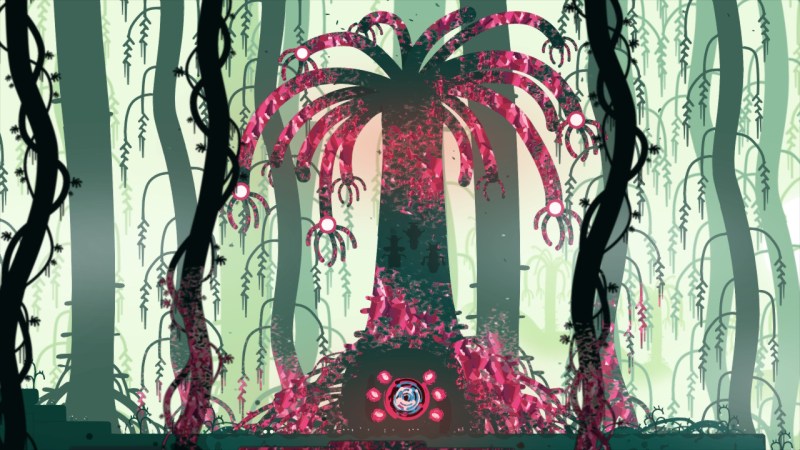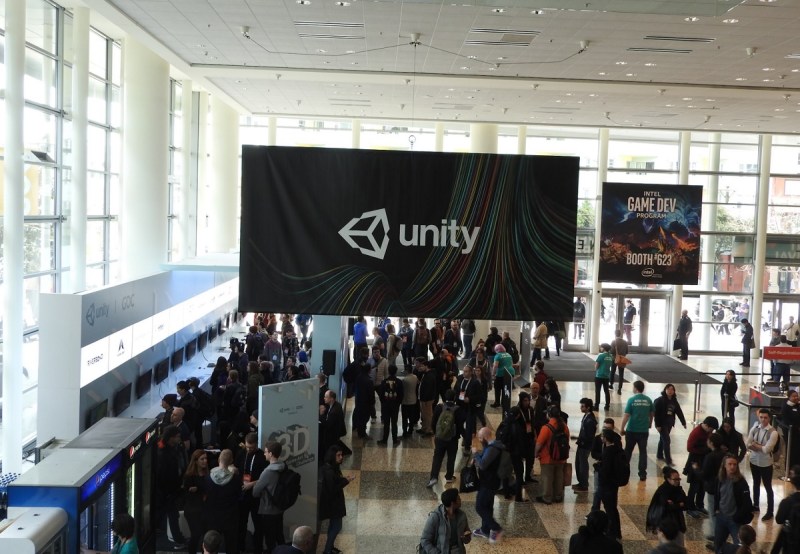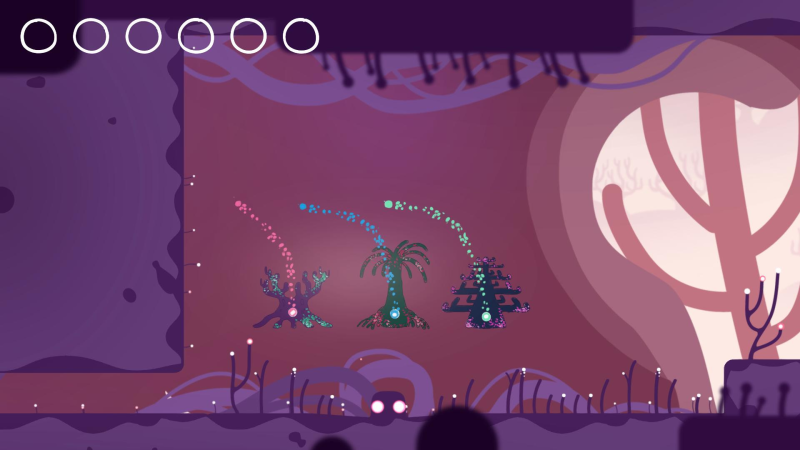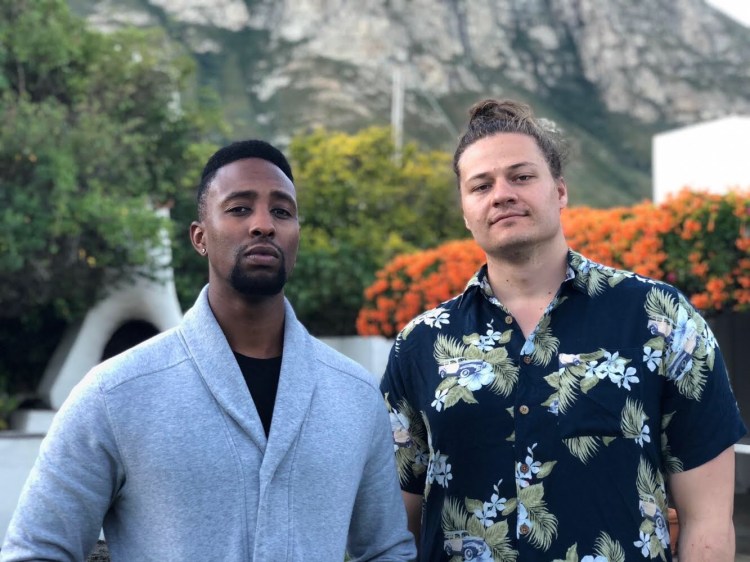In their last year at Johannesburg’s University of Witwatersrand‘s game design program, Cukia “Sugar” Kimani and Ben Myres began working on their thesis project. Kimani had created a rough prototype in which the character could change its shape as well as its Rothko-esque environment, and Myres joined as a level designer. It was supposed to just be something for their portfolio — but then they met former Naughty Dog lead character technical director Judd Simantov. He told them they should turn it into a commercial game.
So they did.
They’d planned to graduate university, try to get a job at a big studio, and take their time learning the industry. But based on Simantov’s advice, Myres and Kimani decided to take the huge risk of forming the indie studio Nyamakop and turning their prototype into a game over the course of around three years — the clever puzzle-platformer Semblance, which they released with the help of publisher Good Shepherd Entertainment on July 24 for PC and Nintendo Switch.
“It was straight out of university into working on this thing full-time, under the tutelage of this really experienced triple-A developer,” said Myres in a phone call with GamesBeat. “That’s how it started.”
But the road hasn’t been easy for Nyamakop. Though the University of Witwatersrand (also called Wits University) offers a lot of emotional support and a passionate community, it doesn’t have the kind of post-graduation resources that programs like New York University or the University of Southern California have. NYU has an incubator program and USC has a publishing label, and both have faculty with deep industry ties. They’re also located in cities with easy access to some of the biggest game companies in the world — like Blizzard in southern California and Take-Two Interactive in New York — and within hours of major games events like the Game Developers Conference in San Francisco, the Electronic Entertainment Expo in Los Angeles, and PAX East in Boston.
Wits’ program focuses on design and the theory of crafting games, without many courses about the business side of things, like how to set up a studio or market a game. So Kimani and Myres had to teach themselves that aspect of game development through a combination of videos of GDC lectures and reading a vast number of articles and blog posts from fellow developers.
“I think, luckily, [the] indie [scene] is very big on sharing. There’s so many blog posts out there that you can look at,” Myres said. “I think Steam Spy was also absolutely crucial. Unbelievably crucial for understanding how well games sold, and when they sold as well.
“When you don’t really understand games, you see, OK, this game sold 500,000 units, and you see it as a lump sum. You don’t necessarily perceive that it sold maybe 50,000 in the first month, and the rest of the time it was big sales [behind those numbers].”
Even though Wits didn’t offer lessons on these business topics, Myres says that the community they found at Wits has been key. The university helped bring the indie event A Maze Festival to Johannesburg, which helped local devs meet international ones. And it created a culture that provided “a safe space to fail” and experiment.
“In a country with 500 to 700 people in the whole industry, having a few hundred people around you making games is no insignificant thing,” said Myres. “You’re surrounded by a culture of people making games. The conversations you have and things like that are very different. You also meet people. Me and Sugar met and ended up working together. Literally, that community is super valuable.”
Getting the most out of events

Above: Nyamakop’s debut game, Semblance.
Nyamakop is passionate about growing the local games community. South Africa does have a few monthly meetups, though most of those are in Cape Town rather than Johannesburg. Myres says that in some ways, helping fellow indie devs in their city succeed is a kind of business decision.
“For us, it’s really important to start growing the community around us specifically in Johannesburg that’s making a lot of stuff. That’s also motivating for us. We can help them. They can help us,” said Myres. “At a practical, emotional level, it’s super important. That’s also why we stayed quite close to Wits University. We could just go visit and be embedded again in a lot of people making games. Even if it’s just one way, us giving feedback, or something like that. It’s really good to be surrounded by people doing the same thing as you, and also saying, oh, the stuff you’re doing is really cool, congrats on that article. Anything like that. It’s just enabling.”
But Myres also espouses the importance of an international and online community. Many of these folks are people he met at events, like A Maze, which got its start in Berlin and brought over European developers to South Africa. He and Kimani have also been to BitSummit in Japan, events like GDC and E3 in the U.S., and Gamescom in Germany. Myres was invited to an event in Tulsa, Oklahoma, and he used it as an opportunity to swing by IndieCade first.
Events are a great place to chat with peers, to meet platform holders, and to get the attention of international press who might not normally be accessible. After you’ve met someone in person, it’s a lot easier to reach out to them via email — whether that’s to ask for coverage, for an introduction, or for advice. This makes events crucial to South African developers, or any indie developer who’s starting out.
In terms of getting media attention, Myres’ advice is to approach press at events, even without a booking. A lot of indies become discouraged when they reach out weeks before an event like GDC and don’t hear a response. He says that it’s a good idea to keep an eye out for press badges — which usually have a different color or something to set it apart from general admission — and ask those people if they’re interested in trying your game.
“If you actually approach press, you’re already in the top 0.1 percent,” said Myres. “I guarantee that most developers aren’t actually approaching press. It sounds bizarre, but they’re kind of like, oh, we haven’t booked press, it’s over.”
Myres also says that “preproduction” is an important aspect of getting ready for an event. This means making sure that your demo can work without you having to be around so you’re free to mingle and coax press over to try your game.
“It’s hard in certain genres, but you should make a demo that’s 10-15 minutes, teaches the player how to play it without you being there,” said Myres. “Someone should be able to play it without you being there. It has an attract mode, a video. You should be able to have your back facing the screen the entire show if you want to get to press. You want someone to be playing, and you’re looking out there for a press badge or something.”
It also helps to find a unique pitch and to practice approaching people proactively without being outright aggressive.
“Even if your game is original, it might not stand out from everyone else. But if you can figure out how to frame it as separate, as an alternative, as punk rock even, people might be more interested,” said Myres. “You’re creating this tension. Oh, this is what other things are doing, but this is why our thing is different and special and completely new. Then, if your demo and your game are good, you’ve won the minute you get them to play.”
A lot of developers aren’t keen on the business side of things. But Myres says that “no part of game development is 100 percent enjoyable.”
“It’s just about finding things you enjoy in it,” said Myres. “The reason I love marketing and PR is because it’s kind of like game design. It’s fun. It’s this challenge. Game design is about making this thing for people to engage with. If you make a good game, that’s really rewarding. If you make a bad game, you figure out how to make it better. It’s the same thing with PR and marketing. How do you figure out how to pitch something to journalists? This idea didn’t work. This idea did, and it was really funny.”
Working nonstop

Above: GDC is one of the industry’s major events.
Crunch time is a pervasive problem in the video game industry, forcing developers to trade mental and physical wellbeing for long work hours, sometimes for weeks on end. For Nyamakop, crunch lasted for something like two years. Myres said that the first time he took a break from development was when he burned out toward the end of 2017.
It’s clear from calls for unionization that folks want workplace protection for developers both from abusive colleagues and from environments that force people to overextend themselves. But sometimes indies don’t have the option to do the healthy thing, and they end up making major sacrifices in order to pursue their goals.
Myres describes how working on Semblance has damaged his relationships and his health. For the first year, he was lecturing at Wits during the day and working on the game at night. By the second year, both he and Kimani were working on it full-time, and he juggled development on top of traveling, which he did three to seven months out of the year. They pitched publishers and events unceasingly. Money was a constant concern. When they were accepted into the Swedish accelerator program Stugan, they bought one-way tickets without knowing how they’d get back to South Africa.
“When I burned out, I’d just had a relationship break down,” said Myres. “Part of the reason I didn’t want to work for a month is because I had this immense pressure for the game to be good and successful. I made all these sacrifices to make this thing. If it comes out and it’s not good and it’s not well received, what did I make all those sacrifices for?”
Myres says that part of the reason why it’s so easy to fall into a toxic way of working is because universities don’t teach students a healthy alternative. College life doesn’t provide any boundaries. Students attend class and then do homework in the after hours. They are in a constant cycle of doing part-time jobs, school, and passion projects seven days a week.
“When you come out of university, you have literally no idea how to work at a normal job. For me personally, it was all-consuming,” said Myres. “It was extremely toxic as well. I had damaged personal relationships. Your body starts to decay. It’s extremely unhealthy, I think. That’s part of a result of the way you’ve worked for three to four years in university. You come out and it’s just a blue sky. You have no structure, but the structure you did have teaches you to work in this constant way, to deliver on these deadlines. It’s really hard to balance.”
But the most nefarious thing about crunch may also be that sometimes it works. Indie darling Night in the Woods’ developer Scott Benson has been outspoken about how his physical health was severely impacted by his and his team’s nonstop work on their award-winning game. Eric “ConcernedApe” Barone developed the hit farm simulator Stardew Valley, which took “nearly life-ruining levels of obsessiveness.” Semblance won the Excellence in Game Design Award at BitSummit and received several nominations at festivals like Brazil’s Independent Games Festival and SXSW. It’s also the first game from Africa on a Nintendo platform.
It’s a tricky calculus to determine whether or not success is worth damaging your personal relationships and possibly dealing irreparable damage to your body. And that’s without any guarantee of success.
“Crunch culture is terrible. We all know this. Everyone needs to unionize,” said Myres. “But when you’re in Africa, and you don’t have the same opportunities [as those in more established regions for game development], you have to just go all in. That’s why so many previews that write about [Semblance] mention the hammy/aggressive way I got them to play the game, because it’s like—you just spent 24 hours and thousands of dollars to fly to E3. You’re not going to just sit there and wait for a journalist to come play your game. You’re gonna go out and get them to play your game. That’s the awkward conversation, especially for indies, about crunch and working so hard. To a certain extent, everyone works super hard in indie games, and sometimes the people who make it are the ones who just worked a little bit harder. It’s a lot of luck. Everyone talks about luck in indie games. But you have to improve the odds somehow.”
Minimizing risk

Above: Nyamakop spent three years developing its student game Semblance into a full release.
Myres says his number-one advice for new indie developers is to “minimize risk.” He describes Nyamakop’s situation as a privileged one — they graduated from Wits without any student debt and their parents were willing to let them both live at home. For the first year, they survived off of $380 per month by cutting back on extraneous costs and not having to pay rent. They also didn’t have to think about supporting children or loved ones, so they were free to chase after the dream of developing a successful indie game.
“I would probably say, unless you are in an extremely good position, no student debt, can survive for quite a long time without a decent salary, then as it is currently, trying to be a full-time indie is—A, it’s hard, and B, it’s probably not necessarily worth it,” said Myres. “It’s probably way better for you to go into a studio, learn, earn a decent salary, and build a network out of being in that studio and leveraging the people that studio knows to grow your own network.”
Another piece of advice is to not shy away from making a commercial game. Often folks who graduate from arts programs don’t want to alter their creative vision, but it’s all about making something that could bring in a decent amount of money so you can work on your next project. He recommends Austin Kleon’s Steal Like an Artist, a book that advocates that the best thing a creative person can do is to get paid for their art.
Myres also points to the free agreement template site DoContract.com as a useful tool for developers to draft up contracts, which he emphasizes are crucial even if they’re not legally binding.
“You just need to write down the terms that you agree with, so that when it comes down to the inevitable, some conflict, you can come back to this thing and say, hey, these are the terms, this is what we agreed on,” said Myres. “And also there’s no assumptions about what everyone should be doing. You don’t assume someone is putting money in. You don’t assume someone will do this much work. It’s written down. Everyone knows what they should be doing.”
If Myres had to go and do it all over again, he says he “wouldn’t necessarily change” how he and Kimani went about their development process. But he also felt a certain kind of numbness once they reached their goal.
“We traveled a lot. We’d been written up on all these sites. But it felt a bit hollow,” said Myres. “It was cool to have reached that. I thought that was the dream. But the dream itself felt a bit empty. It wasn’t worth it if there was no one to be sharing it with, kind of. That part is definitely something I would recommend avoiding if you can. Not tossing away your whole life just to make a platformer.”
IndieBeat is GamesBeat reporter Stephanie Chan’s weekly column on indie projects. If you’d like to pitch a project or just say hi, you can reach her at stephanie@venturebeat.com.

